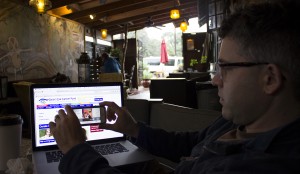
Associated Press

Rebecca Flannery | Staff Writer
By Rebecca Flannery
Staff Writer
Want to test for retinoblastoma, Coats’ disease and cataracts? There’s an app for that.
A team of Baylor professors and an alumnus have come together to create an iPhone app, White Eye Detector, that will aid in early detection of eye diseases which may lead to death and blindness.
Dr. Bryan Shaw, assistant professor in Baylor’s chemistry and biochemistry department, said after the diagnosis of retinoblastoma in his son, he began researching the disease intensely.
“Retinoblastoma is an exclusively pediatric cancer in the eye,” Shaw said. “Pediatricians are supposed to screen for the disease and look for the presence of white reflection in the eye in every checkup after the birth of the child.”
However, Shaw said studies suggest pediatricians don’t detect “white eye” as soon as they should. “White eye” is an indication of leukocoria, and can be a symptom of early-stage retinoblastoma. Oftentimes, parents are the first to detect the disease through observing the eye’s white appearance through pictures of the child, he said.
“My son was diagnosed about five hours after my wife told our pediatrician about the white eye pictures we had of him,” Shaw said. “The pediatrician looked in the eye and didn’t like what she saw, and sent us immediately to the eye doctor. There, he was diagnosed with retinoblastoma.”
The app, which launched Oct. 22, aims to scan for white eyes in two different ways, said Dr. Greg Hamerly, associate professor of computer science, who helped Shaw in research leading up to the app’s creation. The software, Computer Assisted Detector of Leukocoria (CRADLE), was created by the team to scan through all images on the user’s Apple device for instances of white eye. In another feature, the user can hold up the device with the flashlight feature on, and the software will detect a white eye as the camera hovers near the face of the subject.
“If there are any images detected with white eye, they will appear to the user with a warning that the detection may be concerning,” Hamerly said.
From there, it’s up to the user to determine what to do, Shaw said.
The bulk of coding for the app was done by Ryan Henning, a recent Baylor master’s graduate who worked under Hamerly. Henning said he began coding the app on March 27 and finished Aug. 18. About two days later, the team submitted the app to Apple, who took about a month to accept the app with a few minor changes.
“Now we’re just trying to increase accuracy through machine learning,” Henning said.
Machine learning is a technique used to develop the software to work more efficiently. Their team of researchers are using images affected by retinoblastoma as well as images of unaffected eyes to train the app to distinguish between unhealthy and healthy eyes, Hamerly said.
The app has been downloaded in every region of the world, Shaw said. According to the search results on Apple’s app store, it’s the only software of its kind. Because of those statistics, the team is in need of people who can translate the app’s instructions to several different languages, including German, Mandarin, Cantonese, Russian and Farsi, Shaw said.
Shaw said after showing the app to a few practicing doctors, he’s only heard positive feedback.
“I have been getting feedback from my son’s doctors,” Shaw said. “When I pulled out the phone and showed the app to his doctor, a world class ophthalmologist, he loved it. He’s interested.”
Shaw said the survival rate of retinoblastoma in America is 95 percent. That percentage is significantly less in developing countries where Shaw said he hopes this app will be used.
“The software could be the doctor for the little girl who doesn’t have one,” Shaw said.





